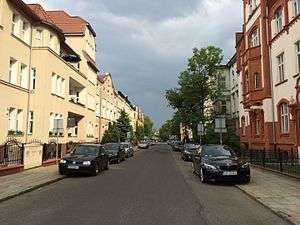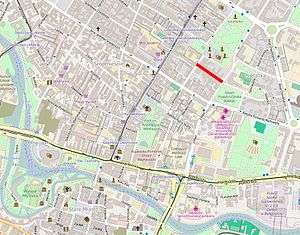Kołłątaja street in Bydgoszcz
| Bydgoszcz | |
|---|---|
| Polish: Ulica Księdza Hugona Kołłątaja | |
|
Eastward view of Kołłątaja street | |
|
Location of Kołłątaja street | |
| Former name(s) | Roonstraße |
| Namesake | Hugo Kołłątaj |
| Owner | City of Bydgoszcz |
| Length |
160 m (520 ft) Google maps |
| Area | Downtown district |
| Location | Bydgoszcz |
| Construction | |
| Construction start | End of 19th century[1] |
| Completion | 1900 |
Kołłątaja street is a historical street of downtown Bydgoszcz.
Location
Kołłątaja street is a short avenue in Bydgoszcz, starting at the intersection with Libelta and Szwalbego streets and heading south-east to Stanisław Staszic street.
History
The street was initially a path allowing access to the first house built in the street from 1899 to 1901, the Shelter for blind children at today's N°9.
A reference to the street was made on 1900 map of Bromberg.[1] On the 1898 address book of Bromberg, the appellation "Roonstraße" appears for the first time, with only two referenced locations.[2]
Through history, the street bore the following names:
- End 19th century-1920, Roonstraße;[2]
- 1920-1939, Księdza Hugona Kołłątaja street;[3]
- 1939-1945, Roonstraße;[4]
- since 1945, Księdza Hugona Kołłątaja street.
The name comes from Hugo Kołłątaj (1750-1812), a Polish Roman Catholic priest, social and political activist, political thinker, historian and philosopher, seen as one of the most prominent figures of the Enlightenment in Poland.
Main edifices
Tenement at N°1, corner with Szwalbego street N°2
1911,[5] by Fritz Weidner
Landhaus style, Eclecticism
Initial address was Roonstraße 8/9-Bachmannstraße 11,[5] it then changed to Libelta street 12 before the creation of Szwalbego street. The tenement has been built for a German housing cooperative, German: Beamten wohnungsverein GmbH. In 1920, it moved to its Polish equivalent structure, Polish: Towarzystwo mieszkaniowe.
The style reminds German Mansion (German: Landhaus) outfits, with massive bay windows, variously shaped gables and asymmetry of the facade, for which Fritz Weidner was prone to. In 1909-1910, this house was identified as part of the winning selection in the Bromberg municipal competition for the most beautiful frontage.[6]
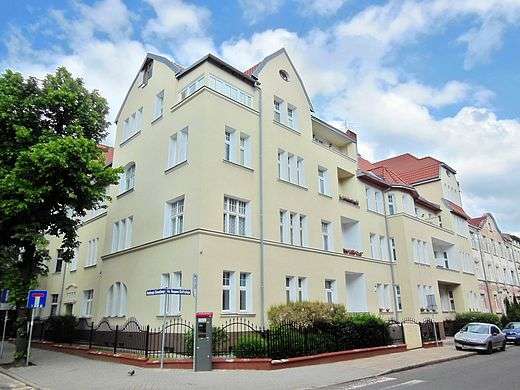 Corner view
Corner view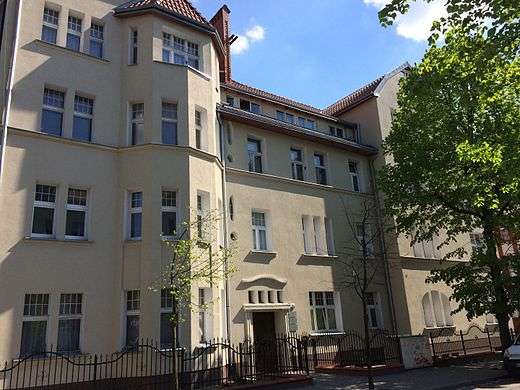 Facade on Szwalbego street
Facade on Szwalbego street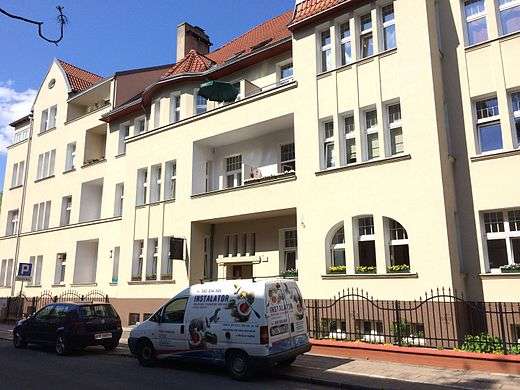 Facade on Hugo Kołłątaj street
Facade on Hugo Kołłątaj street
Tenement at N°2, corner with Libelta street N°10
Registered on Kuyavian-Pomeranian Voivodeship heritage list, Reg.A/1638, July 09th, 2013[7]
1901-1902, by George Weiss[8]
Eclecticism, forms of Art Nouveau[8]
Initially at the corner of Roonstraße and Bachmannstraße streets, the architect Georg Weiss made it his own house, before moving the second one he built in 1907 at Gdańska Street N°141. After the restoration of Poland in 1920 and the Peace of Riga with USSR, the edifice housed displaced Polish families from the Eastern Borderlands.[9] At the end of World War II, the building was devastated by Soviet armed forces, which had a hospital here.[9] After the war, the municipality took over the management of the tenement, being unable to find back its owner.[9]
Perfectly refurbished in 2005, the house is among the highest decorated building in Bydgoszcz: Art Nouveau motifs enlightens the facades (women figures flanked by eagles, vases etc.). Today, it represents one of the pearls of Bydgoszcz architecture of the early 20th century.[9]
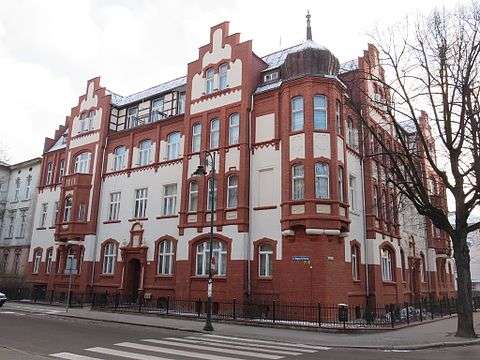 View of the corner
View of the corner- Facade on Hugo Kołłątaj Street
 View from Libelta street
View from Libelta street Motifs crowning the gate
Motifs crowning the gate
Tenement at N°3
1906-1908[10]
Initial address was Roonstraße 10. The first landlord was Constantin Cieslinski, a carpenter[10] who also had the tenement at N°5.
Building's frontage displays particularly Art Nouveau style. On the ground floor, windows are topped with geometrical moldings, and the gate is adorned by an impressive frame, full of motifs (curved shapes, pilasters, vegetal forms). The gate still possesses its original numbering "10" from the Prussian times. Upper levels have lost their decoration: the main gable still boasts a large Art Nouveau ornamentation, including a male face, mingled with long curvy hair, flowers and other ornaments.
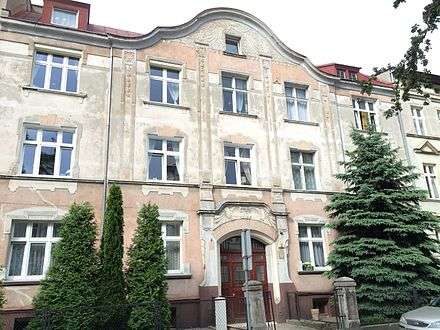 Main elevation
Main elevation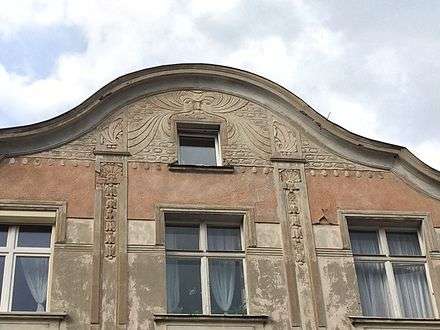 View of the gable
View of the gable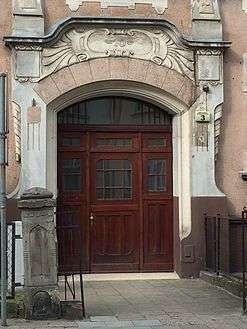 Detail of the gate
Detail of the gate
Tenement at N°4
1898-1899[10]
Eclecticism, forms of early Art nouveau
Roonstraße 5 was property of the Independent Order of Odd Fellows lodge in Bydgoszcz until World War I. The lodge itself was located at Roonstraße 6, via a small pathway leading to the backyard (now the path leading to the backyard of N°4). The Odd Fellows lodge in Bydgoszcz has been disbanded in 1938, together with other obediences housed in the same edifice.[11] The villa is now at Libelta street N°8.
The facade is hidden behind two old trees, but the avant-corps is well visible. The decoration of the latter is marked with late Eclecticism details:
- pilasters on the ground floor flanking large windows topped with figurative lion heads;
- a pediment with floral motifs;
- round windows on the second floor, crowned by an oeil-de-boeuf ornamented with floral motifs and a woman figure in an ogee-roof gable.
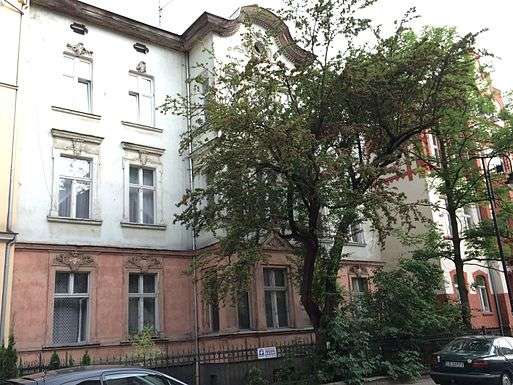 Main elevation
Main elevation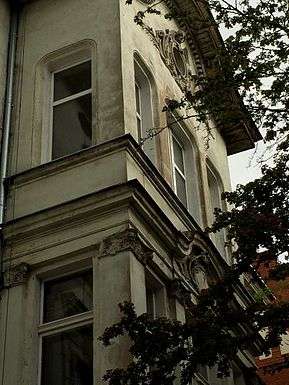 View of the bay window
View of the bay window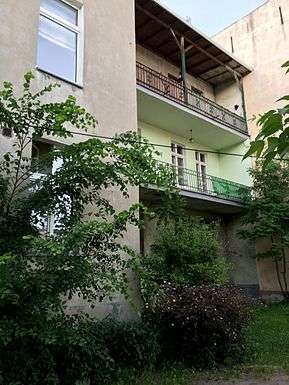 Backyard
Backyard- Former odd Fellows lodge, view from N°4 backyard
Tenement at N°5
1897[10]
Initial address was Roonstraße 11. The first landlord was Constantin Cieslinski, a carpenter[10] who also owned and lived at N°3. After the restoration of Poland in 1920 and the Peace of Riga with USSR, the edifice housed displaced Polish families from the Eastern Borderlands, such as Mrs Korybut-Daszkiewiczów, wife of Michał Kolankowski, wealthy owner of a factory producing stoneware pipes near Novgorod.[9]
The tenement, although built two years prior its neighbour at N°3, is characterised by neo-classicism, still in vogue at the end of the 19th century. The facade features order, symmetry and tidiness with a nice entry gate, pediments on first floor windows and a triangular pediment capping the slight avant-corps of the gate.
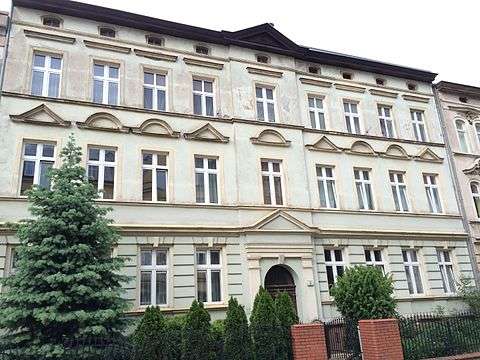 Main elevation
Main elevation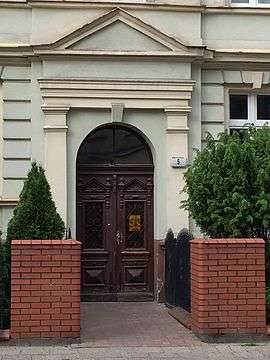 Entry gate
Entry gate
Tenement at N°6
ca 1900[10]
Initial address was Roonstraße 4: the tenement was owned by Carl Gau, a master painter[12] till World War I.
The elevation is a particular example of eclectic style. The asymmetry is characterised by two bay windows of different shapes, with adorned bottoms. One can also highlight the two ogee shaped wall dormers. The facade echoes Fritz Weidner's realisations in Bydgoszcz:
- Thomas Frankowski Tenement (Bydgoszcz);
- Gdańska Street N°79;
- Carl Bradtke Tenement in Bydgoszcz;
- August Cieszkowski Street N°13/15.
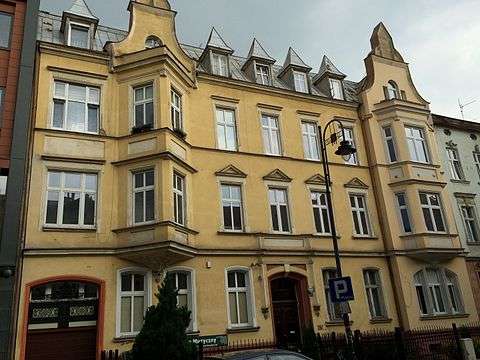 Main elevation
Main elevation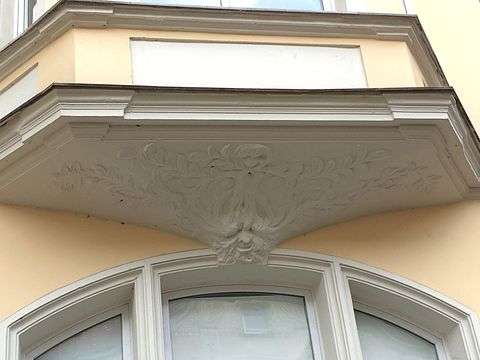 Bottom of a bay window
Bottom of a bay window
Tenement at N°7
1897-1898[10]
Eclecticism, forms of Neo-Baroque
Initial address was Roonstraße 12: the first owner of the tenement was Ignacß Mikulski, a farmer.[13]
The eclectic style is particularly pregnant on the facade. There is a mix of neo-classical details (disposition of the openings, symmetry) and neo-baroque elements (abundance of motifs in the pediments, bay-window flanked with columns).
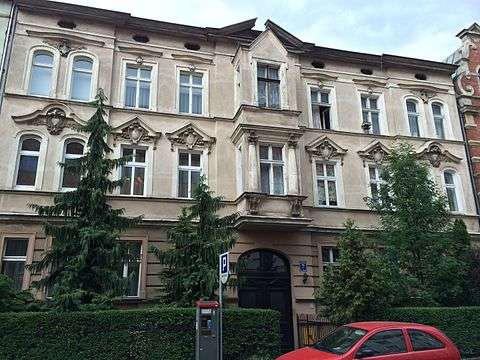 Main elevation
Main elevation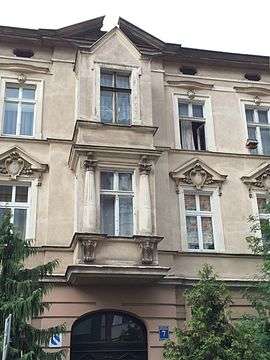 Bay window detail
Bay window detail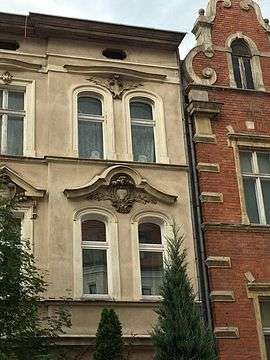 Window decoration
Window decoration
Tenement at N°8
2015[14]
Initial address was Roonstraße 3: the plot was owned by Carl Gau, a master painter, landlord at N°6.[15] The area stayed without any habitation building till after World War II. it is today the seat of the Cooperative bank in Bydgoszcz (Polish: Bank Polskiej Spółdzielczości S.A w Bydgoszczy).
Current building has been realised in 2014 by the firm "Nowoczesne Elewacje". It is made of titanium zinc and Keratwin ceramic tile.[14]
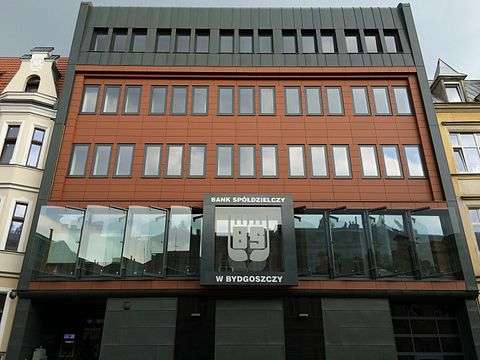 Main facade
Main facade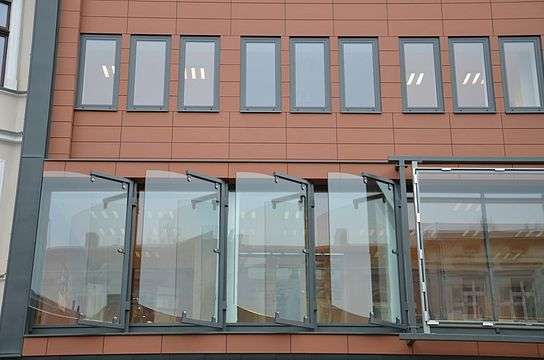 Detail of the facade
Detail of the facade
Ancient shelter for blinds, at N°9 corner with Staszica street
Registered on Kuyavian-Pomeranian Voivodeship heritage list, N° A/1569, August 26, 2010[7]
1899-1901,[10] by Karl Bergner
Eclecticism & Dutch Mannerism
Built at the beginning of the 20th century, the edifice at Roonstraße 13/14 was initially conceived as a refuge for blind children (German: Blindenheim). The initiator of the construction was the director of nearby Educational Centre for Blind Children, Anton Wittig. He organized the "Society for blind people", which, till 1901, collected funds to build a shelter in home Bydgoszcz. The hostel was operational up to 1962, as part of the specialized school.[16] Today the building houses two clinics, Śródmieście (Downtown, 445m2) and Akademicka (Academic, 312m2), and two specialist medical offices for individuals.[17]
In 2015, city authorities have put the building on sale, with an estimated price of 3.5 million PLN.[18]
The building displays eclectic style, with forms referring to Dutch Mannerism. Two other edifices in Bydgoszcz feature such Dutch-mannerist frontages: the former Prussian Eastern Railway Headquarters and the Lloyd palace. Its brick facades are plaster decorated with architectural details. Slight avant-corps, ornamented with bossage, are crowned with volute adorned gables and pinnacles. Windows are topped with cornices. Main entrance on Kołłątaja street bears the inscription "Blindenheim " ("Home for Blind"). It is positioned at the centre of the avant-corps and includes an ornated portal with doric columns.[17]
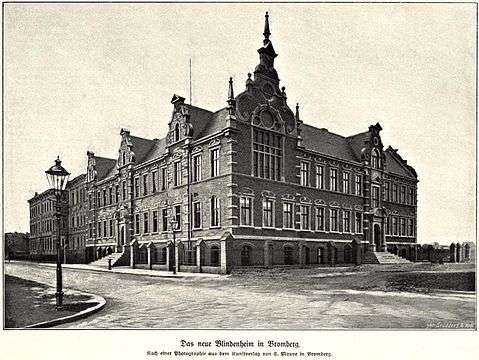 "Blindenheim" ca 1902
"Blindenheim" ca 1902 Current view
Current view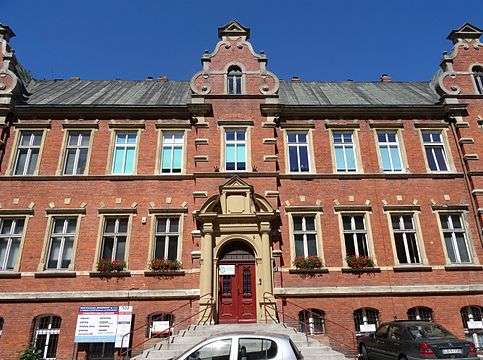 Main elevation on Kołłątaja street
Main elevation on Kołłątaja street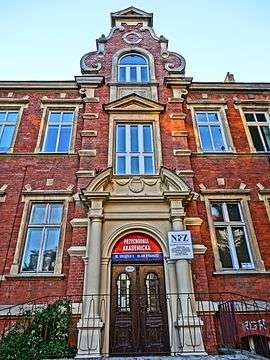 Entrance on Staszica street
Entrance on Staszica street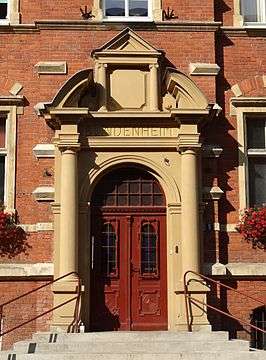 Detail of the portal on Kołłątaja street
Detail of the portal on Kołłątaja street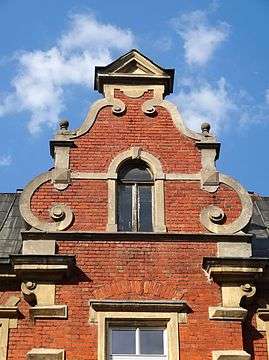 Detail of a gable
Detail of a gable
Jahnte & Bandelow tenement, at N°10
1902-1903[10]
Early Art Nouveau
Initial address was Roonstraße 2: the tenement was the property of two merchants, Albert Jahnte and Oskar Bandelow[19] until the end of World War I. The former had a shop in Elisabeth straße.[20] The latter had two selling points for cigars in Bromberg.[21] In 2013, the building was put on sale.[22] It undergoes a thorough restoration through 2016.
The facade boasts early Art Nouveau style, like round shaped avant-corps, balanced by a triangular bay window. Many architectural details are present: the onion dome capped by a tented roof, several dormers including two giving on balconies, the portal adorned with a plastered female figure inside a pediment, topped by vegetal Art Nouveau ornamentation.
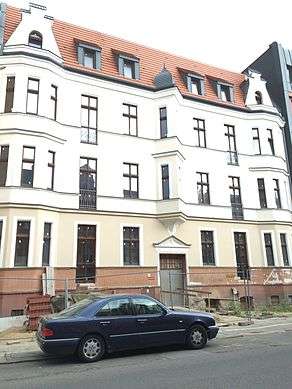 Main facade
Main facade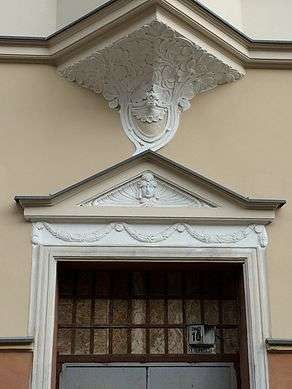 Detail of a bay window
Detail of a bay window
Tenement at Staszica street N°7, corner with Kołłątaja street
1905[23]
Initial address was Braesicke straße 5: the tenement was owned by the municipality, under the name "City apartment association" (German: Wohnungsverein Gehörig).[23] After the restoration of Poland in 1920, it changed to its Polish equivalent structure, Polish: Towarzystwo mieszkaniowe. In 1983, it was purchased to the benefit of Bydgoszcz Music Academy "Feliks Nowowiejski" to house music school departments and lodgings for students. Today, it is part of the network of Bydgoszcz Academy of Music teaching buildings, all located downtown. The tenement also includes:
- a dormitory. Together with the building at Szwalbego N°4, they offer 90 beds;[24]
- a concert hall with 100 seats, situated in the backyard of the tenement at N°5.[24]
The huge building offers sleek facades on both streets. One can underline on Kołłątaja street a sharp triangular bay window topped by a high oitched tented roof with a finial, and on Staszica street a slight avant-corps topped with nice curves and simili pilasters. Both sides display a series of shed dormers, as well as entry gates adorned with a large lintel (Staszica street), and lighter one with flower motifs and a woman head (Kołłątaja side).
 View of the building at Staszica street N°7
View of the building at Staszica street N°7 Facade on Kołłątaja street
Facade on Kołłątaja street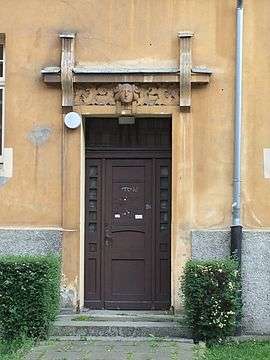 Gate on Kołłątaja street
Gate on Kołłątaja street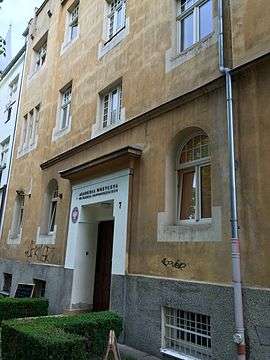 Gate and facade on Staszica street
Gate and facade on Staszica street
See also
| Wikimedia Commons has media related to Kołłątaja Street in Bydgoszcz. |
- Bydgoszcz
- Gdańska Street, Bydgoszcz
- Bydgoszcz Music Academy "Feliks Nowowiejski"
- Gimnazjalna, Libelta and Szwalbego Streets in Bydgoszcz
- Zygmunt Krasiński Street in Bydgoszcz
- L. Braille special educational centre for blind children in Bydgoszcz
- Music Schools Group in Bydgoszcz
- Pomeranian Philharmonic
References
- 1 2 Strassen plan von Bromberg, 1900, A. Fromm.
- 1 2 Adressbuch, nebst allgemeinem Geschäfts-Anzeiger von (1898). "Straßen". Bromberg und dessen Vororten auf das Jahr. Bydgoszcz. p. 60.
- ↑ Adresy Miasta Bydgoszczy 1921
- ↑ Stadtbauhamt Bromberg - 10/07/1941
- 1 2 Adressbuch nebst allgemeinem Geschäfts-Anzeiger von, Bromberg und dessen Vororten auf das Jahr (1911). "Strassen". auf Grund amtlicher und privater Unterlagen. p. 159.
- ↑ Jastrzębska-Puzowska, Iwona (2000). Poglądy artystyczne i twórczość bydgoskiego architekta Fritza Weidnera. Bydgoszcz: MATERIAŁY DO DZIEJOW KULTURY I SZTUKI BYDGOSZCZY I REGIONU 1. p. 45.
- 1 2 zabytek|kujawsko-pomorskie|issued=1.03.2014
- 1 2 Lewińska, Aleksandra (9 January 2015). "Kamienice zmieniają szaty. Więcej pieniędzy na ich remonty". bydgoszcz.wyborcza.pl. bydgoszcz wyborcza. Retrieved 17 May 2016.
- 1 2 3 4 5 Chmielewska, Gizela (14 January 2009). "Historyczny adres: Kołłątaja 2/Libelta 10". pomorska.pl. bydgoszcz pomorska. Retrieved 17 May 2016.
- 1 2 3 4 5 6 7 8 9 Jasiakiewicz, Roman (24 April 2013). Uchwala NR XLI/875/13. Bydgoszcz: Miasta Bydgoszczy. p. 90.
- ↑ "Loża masońska zamknięta na cztery spusty". bydgoszcz.wyborcza.pl. bydgoszcz.wyborcza. 26 November 2012. Retrieved 29 May 2016.
- ↑ Adressbuch nebst allgemeinem Geschäfts-Anzeiger von, Bromberg und dessen Vororten auf das Jahr (1902). "Alphabetisch geordneter nachweis der geschäfts". auf Grund amtlicher und privater Unterlagen. p. 630.
- ↑ Adressbuch nebst allgemeinem Geschäfts-Anzeiger von, Bromberg und dessen Vororten auf das Jahr (1903). "Straßen". auf Grund amtlicher und privater Unterlagen. p. 78.
- 1 2 "Bank Spółdzielczy Bydgoszcz". nowoczesneelewacje.p. netwizards. 2015. Retrieved 29 May 2016.
- ↑ Adressbuch nebst allgemeinem Geschäfts-Anzeiger von, Bromberg und dessen Vororten auf das Jahr (1915). "Straßen". auf Grund amtlicher und privater Unterlagen. p. 133.
- ↑ Kulpiński, Henryk (1975). Sto lat w służbie niewidomych. Bydgoszcz: Kalendarz Bydgoski.
- 1 2 Parucka, Krystyna (2008). Zabytki Bydgoszczy – minikatalog. Bydgoszcz: Krystyna Parucka 2008.
- ↑ Lewińska, Aleksandra; Czajkowska, Małgorzata (19 April 2015). "Zabytkowy gmach przy Kołłątaja zostanie sprzedany. Kto go kupi?". bydgoszcz.wyborcza.pl. Wyborcza pl. Retrieved 30 May 2016.
- ↑ Adressbuch nebst allgemeinem Geschäfts-Anzeiger von, Bromberg und dessen Vororten auf das Jahr (1904). "Straßen". auf Grund amtlicher und privater Unterlagen. p. 81.
- ↑ Adressbuch nebst allgemeinem Geschäfts-Anzeiger von, Bromberg und dessen Vororten auf das Jahr (1904). "Alphabetisch geordneter nachweis der geschäfts". auf Grund amtlicher und privater Unterlagen. p. 79.
- ↑ Adressbuch nebst allgemeinem Geschäfts-Anzeiger von, Bromberg und dessen Vororten auf das Jahr (1904). "Alphabetisch geordneter nachweis der geschäfts". auf Grund amtlicher und privater Unterlagen. p. 6.
- ↑ "Dom Śródmieście, Kołłątaja". nieruchomosci-online.pl. Nieruchomosci-online. 19 September 2013. Retrieved 30 May 2016.
- 1 2 Adressbuch nebst allgemeinem Geschäfts-Anzeiger von, Bromberg und dessen Vororten auf das Jahr (1905). "Straßen". auf Grund amtlicher und privater Unterlagen. p. 23.
- 1 2 "Dom studenta". amuz.bydgoszcz.pl. agencja kreatywna. 2016. Retrieved 30 May 2016.
External links
Bibliography
- (in Polish) Henryk Kulpiński - Sto lat w służbie niewidomych in Kalendarz Bydgoski 1975
- (in Polish) Janusz Umiński - Regionalny Oddział PTTK „Szlak Brdy”, Bydgoszcz Przewodnik 1996
Coordinates: 53°04′N 18°00′E / 53.07°N 18.00°E
